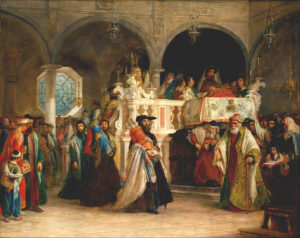The unique tunes of Italian Jewish sound and the lyrical quality of Rav Richetti chants
If you were asked to hum a tune that sounded Jewish, what would you hum? An American might choose a song like “I Have a Little Dreydl” or “Hava Nagilah”. However, it is important to understand that regardless of your choice, the entire range of Jewish musicality cannot be summarized by just one song (unless you were to sing the Song of the Sea to Moses’ actual tune). Over the last two thousand years, Jews have adopted musical ideas from many other cultures.
Mizrachi Jews use the Arabic maqam system. Some Chasidic nigunim are written in scales which are common in Russian folk music. In Italy, Sephardic and Ashkenazic Jews, who have been influenced by local secular musical traditions since the Baroque period, have developed unique musical traditions which distinguish them from Sephardic and Ashkenazic congregations in other countries.
The Tuscan port city of Livorno has been a meeting point for many different Sephardic traditions. Jews from North Africa, Western Europe, and the Eastern Mediterranean settled in Livorno, and each brought with them unique musical traditions. An already multifaceted tradition developed further as it was influenced by the Baroque styles of Christian Italy. Consequently, Livornese Jewish liturgical music has contained ornate instrumental accompaniments as early as the 1700s.
Some eighteenth century Livornese Jewish manuscripts even use the terms “aria” and “recitative” when discussing Jewish wedding performances — terms which come out of the secular opera. The Great Synagogue of Livorno became especially well-known for its choir. While most Sephardic synagogues used congregational melodies which were sung in unison, the Livornese synagogue used choral music from French Ashkenazi synagogues.
Jews in Livorno also started to write their own tunes based on the Italian art song tradition. Livornese Purim songs are particularly well-known today. These songs contain few ornaments and syncopated portions, so they were easily accessible to the Western ear. Whereas traditional Sephardic and Ashkenazic melodies were typically modal, the new congregational melodies in Livorno followed the same basic tonal progression as popular secular music. During the classical period in Europe, more people started to study music, and the same was true in the Jewish community in Livorno. Many people played instruments and sang well, and with this growth of musical skill and sophistication came the creation of a strong musical culture in their synagogue.
The music of the Ashkenazi synagogues in Northern Italy was also influenced by the sounds of Italian secular culture. Although the musical modes were similar to those used by Ashkenazim in Western Europe, the rhythmic style is more structured. This was evident in a concert of Italian Ashkenazi hazzanut given by Rav Elia Richetti in New York in 2017. Hazzanut is the art of chanting Jewish liturgy, and when most Americans think of hazzanut, they think of a very specific type of vocal music which originated in Eastern Europe and was further developed in New York in the early twentieth century.
I was struck by Rav Richetti’s beautiful annunciation of each consonant— a feature which is common in Italian art songs. Works of Eastern European hazzanut typically consist of long melismas, and the vowel shape often changes over the duration of a melisma. While Richetti’s style also contained some melismatic phrasing, the music has a more lyrical quality than most works of Eastern European hazzanut.
The Jewish population in Italy has changed significantly over the last century. Some Jews became more secular, and others left Italy altogether. The changes in population led to Jews of different rites attending the same synagogues, making it more difficult to preserve the unique traditions which were specific to particular rites. Rav Richetti was one of the only people with deep and extensive knowledge of the Italian style of Ashkenazi hazzanut. Sadly, Rav Richetti passed away this past April.
Even though the Livorno synagogue still prays using the Sephardic rite, few of its members are actually of Spanish and Portuguese descent. Most of the Italian Jewish population in Italy today resides in Rome and Milan, and the traditional Italian rite is most prominent in those communities. While it is sad to see certain old traditions disappear, it is exciting to think about future traditions which might develop. Just as Italian, Sephardic and Ashkenazic liturgical music developed into unique Italian versions, so too will the current Jewish population of Italy create its own sound based on traditional and modern influences.
Above, The Feast of the Rejoicing of the Law at the Synagogue in Leghorn by Alexander Hart (1850). Leghorn is an archaic English version for the Italian city of Livorno.
* This piece is part of a series of articles written by students of Muhlenberg College, Pennsylvania, USA, enrolled in a course on the history and culture of Jewish Italy, taught by Dr. Daniel Leisawitz, Assistant Professor of Italian and Director of the Muhlenberg College Italian Studies Program.

